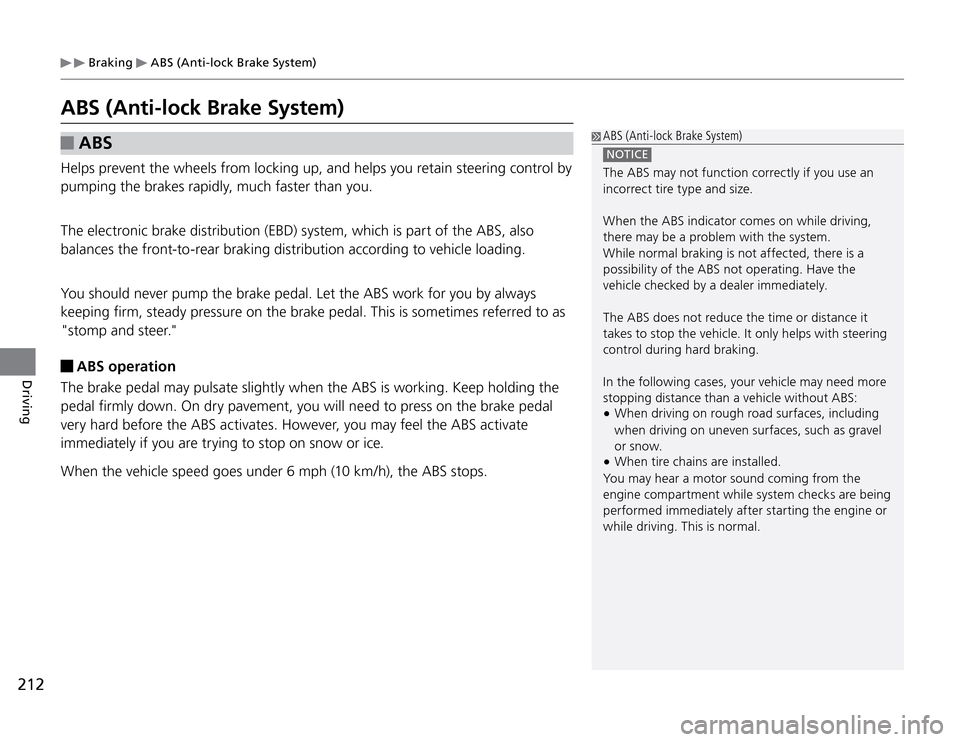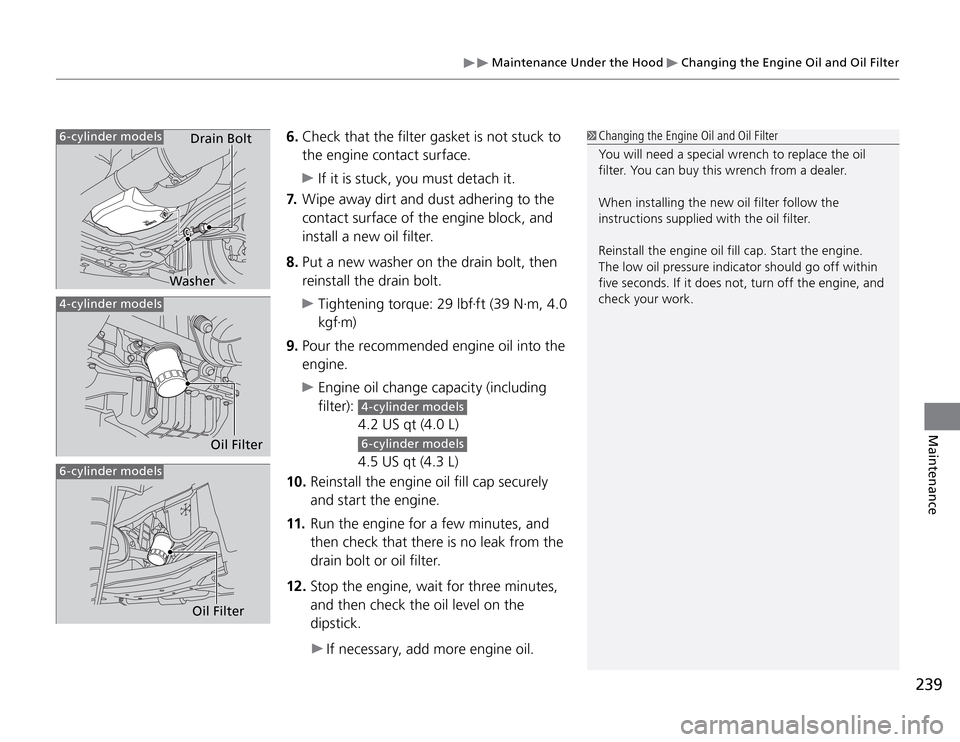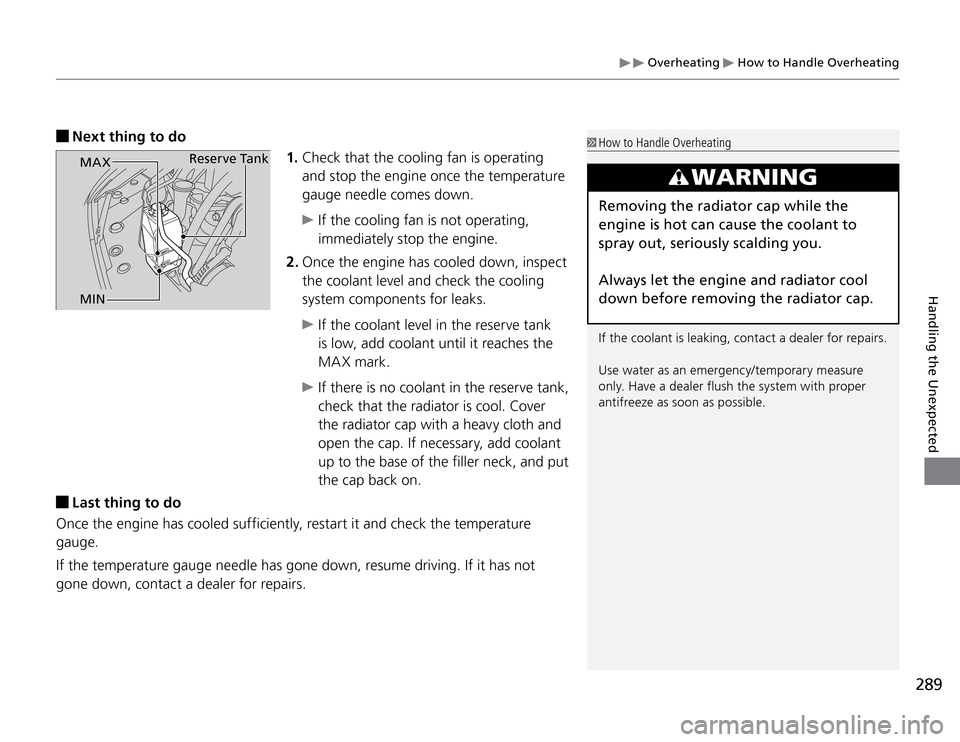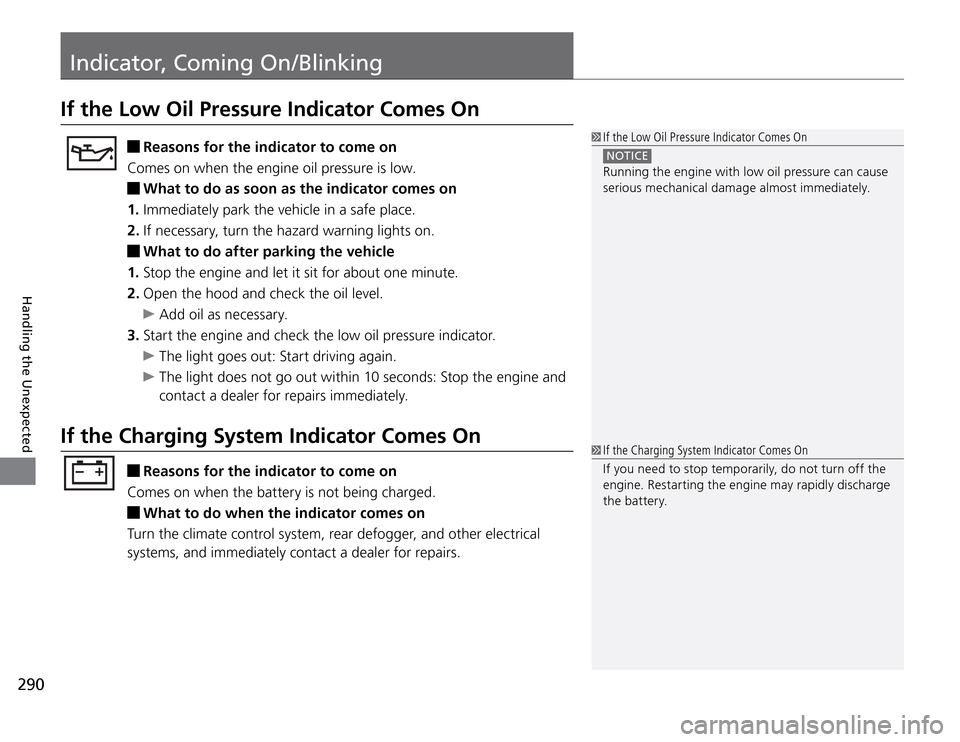stop start Acura TSX 2011 User Guide
[x] Cancel search | Manufacturer: ACURA, Model Year: 2011, Model line: TSX, Model: Acura TSX 2011Pages: 324, PDF Size: 7.85 MB
Page 195 of 324

194Driving
When Driving
Automatic Transmission
Automatic Transmission
Creeping
The following conditions cause the engine to run at high revolutions, and increase
creeping:
Immediately after the engine starts. �t
When the climate control system is in use. �t
Keep the brake pedal firmly depressed when stopped.
Kickdown
Depressing the accelerator pedal while driving uphill may cause the transmission
to drop to a lower gear, unexpectedly increasing vehicle speed. Depress the
accelerator pedal carefully, especially on slippery roads and curves.
Page 201 of 324

200Driving
When Driving
Shifting
Reverse Lockout
The manual transmission has a lockout mechanism that stops you from accidentally
shifting into
R
from a forward gear while the vehicle is moving at a certain
speed.
If you cannot shift to
R
when the vehicle is stopped, do the following:
1. Depress the clutch pedal, move the shift
lever all the way to the left, and shift
to
R
.
2. If you still cannot shift into
R
, apply the
parking brake, and turn the ignition switch
to ACCESSORY
I or LOCK
0
.
3. Depress the clutch pedal and shift into
R
.
4. Keep depressing the clutch pedal and start
the engine.
Have the vehicle checked by a dealer if you
have to go through this procedure repeatedly.
Page 206 of 324

205
Driving
When Driving
VSA
® (Vehicle Stability Assist), aka ESC (Electronic Stability Control), System
VSA
® On and Off
This button is on the driver side control
panel. To turn the VSA
® system on and off,
press and hold it until you hear a beep.
VSA
® will stop and the indicator will come
on.
To turn it on again, press the
(VSA
® OFF)
button until you hear a beep.
VSA
® is turned on every time you start the
engine, even if you turned it off the last time
you drove the vehicle.
VSA
® (Vehicle Stability Assist), aka ESC (Electronic Stability
Control), System
Without VSA
®, your vehicle will have normal braking
and cornering ability, but it will not have VSA
®
traction and stability enhancement.
In certain unusual conditions when your vehicle gets
stuck in shallow mud or fresh snow, it may be easier
to free it with the VSA
® temporarily switched off.
When the VSA
® system is off, the traction control
system is also off. You should only attempt to free
your vehicle with the VSA
® off if you are not able to
free it when the VSA
® is on.
Immediately after freeing your vehicle, be sure
to switch VSA
® on again. We do not recommend
driving your vehicle with the VSA
® and traction
control systems switched off.
If the low tire pressure/ TPMS indicator comes on or
blinks, the VSA
® system comes on automatically.
In this case, you cannot turn the system off by
pressing the
button.
You may hear a motor sound coming from the
engine compartment while system checks are being
performed immediately after starting the engine or
while driving. This is normal.
VSA
® OFF
Indicator
Page 211 of 324

Braking
210Driving
Brake System
Parking Brake
Use the parking brake to keep the vehicle stationary when parking.
To a p p l y :
Pull the lever fully up without pressing the
release button.
To r e l e a s e :
1. Pull the lever slightly, and press and hold
the release button.
2. Lower the lever down all the way, then
release the button.
Parking Brake NOTICE Release the parking brake fully before driving. The
rear brakes and axle can be damaged if you drive
with the parking brake applied.If you start driving without fully releasing the
parking brake, a buzzer sounds as a warning, and
"RELEASE PARKING BRAKE" appears on the multi-
information display.
Always apply the parking brake when parking.
To prevent the parking brake from freezing when
the outside temperature is extremely cold, do not
apply it, but do the following: Automatic transmission models Put the shift lever in
P, then use a block or other
wheel chock to stop the wheels from turning.
Manual transmission models Put the shift lever in
R or
1, then use a block or
other wheel chock to stop the wheels from turning.
Page 213 of 324

Braking
ABS (Anti-lock Brake System)
212Driving
ABS (Anti-lock Brake System)
ABS
Helps prevent the wheels from locking up, and helps you retain steering control by
pumping the brakes rapidly, much faster than you.
The electronic brake distribution (EBD) system, which is part of the ABS, also
balances the front-to-rear braking distribution according to vehicle loading.
You should never pump the brake pedal. Let the ABS work for you by always
keeping firm, steady pressure on the brake pedal. This is sometimes referred to as
"stomp and steer."
ABS (Anti-lock Brake System) NOTICE The ABS may not function correctly if you use an
incorrect tire type and size.
When the ABS indicator comes on while driving,
there may be a problem with the system.
While normal braking is not affected, there is a
possibility of the ABS not operating. Have the
vehicle checked by a dealer immediately.
The ABS does not reduce the time or distance it
takes to stop the vehicle. It only helps with steering
control during hard braking.
In the following cases, your vehicle may need more
stopping distance than a vehicle without ABS:
When driving on rough road surfaces, including �twhen driving on uneven surfaces, such as gravel
or snow.
When tire chains are installed. �tYou may hear a motor sound coming from the
engine compartment while system checks are being
performed immediately after starting the engine or
while driving. This is normal.
ABS operation
The brake pedal may pulsate slightly when the ABS is working. Keep holding the
pedal firmly down. On dry pavement, you will need to press on the brake pedal
very hard before the ABS activates. However, you may feel the ABS activate
immediately if you are trying to stop on snow or ice.
When the vehicle speed goes under 6 mph (10 km/h), the ABS stops.
Page 240 of 324

Maintenance Under the Hood
Changing the Engine Oil and Oil Filter
239
Maintenance
6. Check that the filter gasket is not stuck to
the engine contact surface.
If it is stuck, you must detach it.
7. Wipe away dirt and dust adhering to the
contact surface of the engine block, and
install a new oil filter.
8. Put a new washer on the drain bolt, then
reinstall the drain bolt. Tightening torque: 29 lbf∙ft (39 N∙m, 4.0
kgf∙m)
9. Pour the recommended engine oil into the
engine. Engine oil change capacity (including
filter):
4-cylinder models 4.2 US qt (4.0 L) 6-cylinder models
4.5 US qt (4.3 L)
10. Reinstall the engine oil fill cap securely
and start the engine.
11. Run the engine for a few minutes, and
then check that there is no leak from the
drain bolt or oil filter.
12 . Stop the engine, wait for three minutes,
and then check the oil level on the
dipstick.
If necessary, add more engine oil.
Changing the Engine Oil and Oil Filter
You will need a special wrench to replace the oil
filter. You can buy this wrench from a dealer.
When installing the new oil filter follow the
instructions supplied with the oil filter.
Reinstall the engine oil fill cap. Start the engine.
The low oil pressure indicator should go off within
five seconds. If it does not, turn off the engine, and
check your work.
Oil Filter
4-cylinder models 6-cylinder models 6-cylinder models
Oil Filter Drain Bolt
Washer
Page 290 of 324

Overheating
How to Handle Overheating
289
Handling the Unexpected
Last thing to do
Once the engine has cooled sufficiently, restart it and check the temperature
gauge.
If the temperature gauge needle has gone down, resume driving. If it has not
gone down, contact a dealer for repairs.
How to Handle Overheating
If the coolant is leaking, contact a dealer for repairs.
Use water as an emergency/temporary measure
only. Have a dealer flush the system with proper
antifreeze as soon as possible.
Next thing to do
1. Check that the cooling fan is operating
and stop the engine once the temperature
gauge needle comes down.
If the cooling fan is not operating,
immediately stop the engine.
2. Once the engine has cooled down, inspect
the coolant level and check the cooling
system components for leaks. If the coolant level in the reserve tank
is low, add coolant until it reaches the
MA X mark. If there is no coolant in the reserve tank,
check that the radiator is cool. Cover
the radiator cap with a heavy cloth and
open the cap. If necessary, add coolant
up to the base of the filler neck, and put
the cap back on.
WARNING
Removing the radiator cap while the
engine is hot can cause the coolant to
spray out, seriously scalding you.
Always let the engine and radiator cool
down before removing the radiator cap.
Reserve Tank
MAX
MIN
Page 291 of 324

Indicator, Coming On/Blinking
290Handling the Unexpected
If the Low Oil Pressure Indicator Comes On
Reasons for the indicator to come on
Comes on when the engine oil pressure is low. What to do as soon as the indicator comes on
1. Immediately park the vehicle in a safe place.
2. If necessary, turn the hazard warning lights on. What to do after parking the vehicle
1. Stop the engine and let it sit for about one minute.
2. Open the hood and check the oil level.
Add oil as necessary.
3. Start the engine and check the low oil pressure indicator. The light goes out: Start driving again. The light does not go out within 10 seconds: Stop the engine and
contact a dealer for repairs immediately.
If the Charging System Indicator Comes On
Reasons for the indicator to come on
Comes on when the battery is not being charged. What to do when the indicator comes on
Turn the climate control system, rear defogger, and other electrical
systems, and immediately contact a dealer for repairs.
If the Low Oil Pressure Indicator Comes On NOTICE Running the engine with low oil pressure can cause
serious mechanical damage almost immediately. If the Charging System Indicator Comes On
If you need to stop temporarily, do not turn off the
engine. Restarting the engine may rapidly discharge
the battery.
Page 292 of 324

Indicator, Coming On/Blinking
If the Malfunction Indicator Lamp Comes On or Blinks
291
Handling the Unexpected
If the Malfunction Indicator Lamp Comes On or
Blinks
If the Malfunction Indicator Lamp Comes On or Blinks NOTICE If you drive with the malfunction indicator lamp on,
the emissions control system and the engine could
be damaged.
If the malfunction indicator lamp blinks again when
restarting the engine, drive to the nearest dealer
at 31 mph (50 km/h) or less. Have your vehicle
inspected.
Reasons for indicator lamp to come on or blink
Comes on when there is a problem with the engine emissions control �t
system, or the fuel fill cap is missing, or loose.
Blinks when engine misfiring is detected. �t What to do when the indicator lamp comes on
Avoid high speeds and immediately get your vehicle inspected at your
dealer. What to do when the indicator lamp blinks
Park the vehicle in a safe place with no flammable items and wait at
least ten minutes or more with the engine stopped until it cools.
Tighten Fuel Fill Cap Message The message appears on when:
An evaporative system leak is detected. This may be caused by the fuel fill cap
being loose or not being installed. What to do when the message appears:
1. Stop the engine.
2. Check that the fuel fill cap is fully installed.
If not, loosen the cap, and then retighten it until it clicks at least once.
3. Drive for several days of normal driving.
The message should go off.
When the malfunction indicator lamp comes on:
Malfunction indicator lamp comes on if the system continues to detect a leak
of gasoline vapor. If this happens, check the fuel fill cap using the procedures
described above.
Page 293 of 324

Indicator, Coming On/Blinking
If the Brake System Indicator Comes On
292Handling the Unexpected
If the Brake System Indicator Comes On
Reasons for the indicator to come on
The brake fluid is low. �t
There is a malfunction in the brake system. �t What to do when the indicator comes on while driving
Press the brake pedal lightly to check pedal pressure.
If normal, check the brake fluid level the next time you stop. �t
If abnormal, take immediate action. If necessary, downshift the �t
transmission to slow the vehicle using engine braking.
If the Brake System Indicator Comes On
Have your vehicle repaired immediately.
It is dangerous to drive with low brake fluid. If
there is no resistance from the brake pedal, stop
immediately in a safe place. If necessary downshift
the gears.
If the brake system indicator and ABS indicator
come on simultaneously, the brake distribution
system is not working. This can result in vehicle
instability under sudden braking.
Have your vehicle inspected by a dealer immediately.
U.S.
CanadaIf the EPS Indicator Comes On
Reasons for the indicator to come on
Comes on when there is a problem with EPS. �t
If you depress the accelerator pedal repeatedly to increase the �t
engine speed while the engine is idling, the indicator comes on, and
sometimes the steering wheel becomes harder to operate. What to do when the indicator comes on
Stop the vehicle in a safe place and restart the engine.
If the indicator comes on and stays on, immediately have your vehicle
inspected by a dealer.
If the EPS Indicator Comes On NOTICE If you repeatedly turn the steering wheel at an
extremely low speed, or hold the steering wheel
on the full left or right position for a while, the
system heats up. The system goes into a protective
mode, and limits its performance. The steering
wheel becomes harder and harder to operate. Once
the system cools down, EPS is restored. Repeated
operation under these conditions can eventually
damage the system.